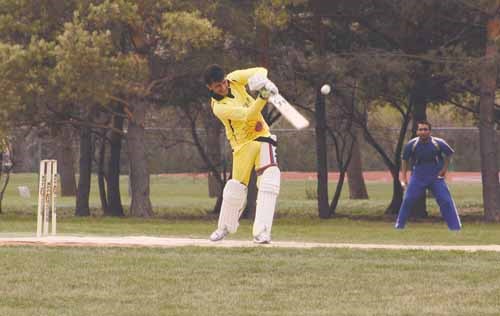By the mood in the Yorkton Yorkers camp following the opening of T-20 cricket season in Regina Sunday, you'd never know the team had just lost its first two games.
"Considering it was our first time out, we did really well," said Faisal Anwar, Yorkers captain. "Now we know what we need to work on."
Anwar was pleased overall with the team's bowling and batting and was surprised by the quality of wicket keeping, for which he had limited expectations. He identified fielding, both in placement of fielders and execution of catches as the priority for the team moving forward.
Vice-captain, Raja Ramachandran, added running between the wickets as an area for improvement.
"We need to communicate better," he said. "We left a few runs out there."
In the first game, the Yorkers came up against some heavy Royals hitters. The initial pair picked apart the Yorkers defence placing the ball in the gaps for numerous boundaries (4 runs) and a number of maximums (6 runs).
The Yorkers did themselves few favours having several opportunities to get these important two wickets, but dropping at least five fly balls.
When it was Yorkton's time to bat, the team was chasing an almost unreachable score of 201 to win. Perhaps showing some nerves on top of inexperience, Yorkers batsmen were only able to muster 93 runs.
In the end it was the Royals' match with a win by 107 runs.
On the plus-side, Anwar said, the team only gave up six wickets managing to complete all 20 overs versus a polished Royals bowling attack.
In the second game versus the Jaguars, the Yorkers found their bats and their fielding legs.
After winning the coin toss, Anwar chose to bat first. The Yorkers batsmen, led by Tinku Sharma's half-century (50 runs), put up 120 runs for seven wickets lost.
With confidence boosted by a defendable total, the Yorkers defended well, taking the very important first three wickets within six overs.
By the 20th over, Yorkton had nine wickets and five runs in hand. With the very bottom of the Jaguars batting order at the crease and Anwar bowling, one more wicket or holding the home team to four runs would give the fledgling team from the Parkland its first win.
Unfortunately, on the very first ball, the Jaguars batsman managed a chip shot behind him over the wicket keepers' head perfectly placed between third man and fine leg that ran for the boundary and four runs.
On the second ball, Anwar delivered a wide ball giving the Jaguars the tie at 120. Anwar brought all the fielders in for the next delivery to guard against the single, but the Jaguars were up to the task, putting bat on ball and running for the win by one wicket with four balls to go.
The Yorkers play the Jaguars again May 25, this time in a 40-over match.
Over: Six deliveries of the ball.
Match: 20 overs per team (120 balls).
Wicket: A batsman who is called out (10 wickets per team per match).
Run: Each time both batsmen successfully run the length of the pitch.
Boundary: Ball reaches boundary on the ground, four runs.
Maximum: Ball goes over boundary in the air, six runs.
Results in cricket matches are expressed in one of two ways:
If both teams manage to complete all of their 20 overs (i.e., the team batting first wins), the team with more runs is said to have won by the difference between the two scores. In Game 1, the Royals beat the Yorkers by 107 runs.
If the second team batting covers the score of the first team without completing 20 overs, it is said to have won by the number of wickets (batsmen who are not out) it has remaining. In Game 2, the Jaguars beat the Yorkers by one wicket.




